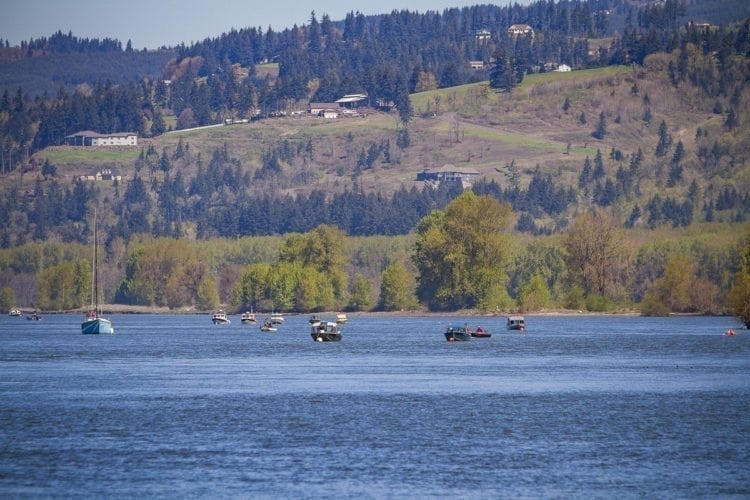A variety of unfavorable environmental conditions, including severe flooding in rivers and warm ocean water, have reduced the number of salmon returning to Washington’s rivers
OLYMPIA — With low returns of chinook and coho salmon expected back to numerous rivers in Washington, state and tribal co-managers Tuesday agreed on a fishing season that meets conservation goals for wild fish while providing fishing opportunities on healthy salmon runs.
The 2018-19 salmon fisheries, developed by the Washington Department of Fish and Wildlife (WDFW) and treaty tribal co-managers, were finalized during the Pacific Fishery Management Council’s meeting in Portland, Ore.

Information on recreational salmon fisheries in Washington’s ocean waters and the Columbia River is available at http://wdfw.wa.gov/fishing/northfalcon/. The webpage also includes information on some notable Puget Sound sport fisheries, as well as an overview of chinook and coho fishing opportunities in the Sound’s marine areas.
A variety of unfavorable environmental conditions, including severe flooding in rivers and warm ocean water, have reduced the number of salmon returning to Washington’s rivers in recent years, said Ron Warren, head of WDFW’s fish program.
In addition, the loss of quality rearing and spawning habitat continues to take a toll on salmon populations throughout the region, where some stocks are listed for protection under the federal Endangered Species Act, he said.
“It’s critical that we ensure fisheries are consistent with ongoing efforts to protect and rebuild wild salmon stocks,” Warren said. “Unfortunately, the loss of salmon habitat continues to outpace these recovery efforts. We need to reverse this trend. If we don’t, salmon runs will continue to decline and it will be increasingly difficult to develop meaningful fisheries.”
Columbia River
Below are highlights of the major Columbia River salmon fisheries this year. More details will be in the 2018-19 Washington Sport Fishing Rules pamphlet, which will be available in June.
Summer fishery — The summer season on the mainstem Columbia River will be open from the Astoria-Megler Bridge upstream to Bonneville Dam from June 22 through July 4 for hatchery (adipose fin-clipped) summer chinook. Bonneville Dam to Hwy. 395 near Pasco will be open from June 16 through July 31. The daily adult limit will be two hatchery salmonids. All sockeye must be released.
Fall fisheries — During fall fisheries, anglers fishing from the same boat may continue fishing for salmon until all anglers have reached their daily limits in the following areas of the mainstem Columbia River:
- Buoy 10 salmon fishery will be open from Aug. 1 through Aug. 24 for adult chinook retention. The daily adult limit is one salmonid (chinook, hatchery coho or hatchery steelhead). From Aug. 25 through Dec. 31, the daily adult limit is two salmonids, but chinook must be released.
- Rocky Point/Tongue Point line upstream to the Lewis River will be open from Aug. 1 through Sept. 2 for adult chinook retention. The daily adult limit is one salmonid. From Sept. 3 through Dec. 31, the adult daily limit is two salmonids, but chinook must be released.
- Lewis River upstream to Bonneville Dam will be open Aug. 1 through Sept. 14 for adult chinook retention. The daily adult limit is one salmonid. During Sept. 15 through Dec. 31, anglers will have a daily adult limit of two salmonids, but chinook must be released.
- Bonneville Dam upstream to the Hwy. 395 Bridge at Pasco will be open Aug. 1 through Dec. 31 with a daily adult limit of two salmonids with no more than one chinook.
Sockeye, chum and jacks — Columbia River anglers are reminded that retention of sockeye and chum salmon is prohibited. Catch limits for jack salmon – salmon that return at a younger age – follow typical permanent regulations and will be listed in the 2018-19 pamphlet. Hatchery steelhead daily limit is one from Buoy 10 to Hwy. 395 Bridge at Pasco from Aug. 1 through Dec. 31.
Commitment to the future
A bright spot in this year’s salmon season planning process was a renewed commitment by Indian and non-Indian fishermen to work together for the future of salmon and salmon fishing, said Lorraine Loomis, chair of the Northwest Indian Fisheries Commission.
“No fisherman wants to catch the last salmon. We know that the ongoing loss of habitat, a population explosion of hungry seals and sea lions and the needs of endangered southern resident killer whales are the real challenges facing us today. We must work together if we are going to restore salmon to sustainable levels,” she said.
Low returns of some salmon stocks prompted state and tribal fishery managers to limit opportunities in many areas to protect those fish.
For example, recreational anglers will have less opportunity to fish for chinook salmon in both the Columbia River and Washington’s ocean waters compared to recent years. Tribal fisheries also will be restricted in certain areas to protect weak stocks.
In meeting conservation objectives for wild salmon, the co-managers are limiting fisheries in areas where southern resident killer whales are known to feed. The adjustments will aid in minimizing boat presence and noise, and decrease competition for chinook and other salmon in areas critical to the declining whales.
Details on all recreational salmon fisheries will be provided in the 2018-19 Washington Sport Fishing Rules pamphlet, which will be available in late June.
For information on tribal fisheries, contact the Northwest Indian Fisheries Commission (http://nwifc.org/).




